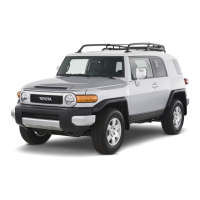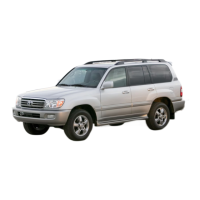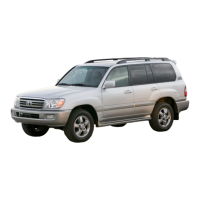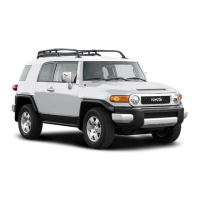
Do you have a question about the Toyota 2007 FJ Cruiser and is the answer not in the manual?
| Brand | Toyota |
|---|---|
| Model | 2007 FJ Cruiser |
| Category | Automobile |
| Language | English |
Provides contact numbers for Toyota Customer Experience Center and Servco Automotive Customer Services.
Explains the types of warnings, their appearance, and how they are used in the manual.
Explains the meaning of the safety symbol found throughout the manual.
Highlights the importance of reading about seat belts, SRS airbags, and child restraint systems.
Describes the vehicle's Event Data Recorder (EDR) and the information it may record in a crash.
Details the types of Toyota limited warranties applicable to the new vehicle.
Emphasizes owner's responsibility to ensure specified maintenance is performed.
Warns about chemicals in engine exhaust and vehicle components known to cause cancer.
Advises on handling battery components containing lead and lead compounds.
Warns that Toyota does not warrant non-genuine parts and their impact on performance or warranty.
Advises checking with dealer for measures regarding installation affecting electronic systems.
Warns about effects of improper tire pressure and excess load on vehicle control.
Instructs to have SRS airbag and seat belt pretensioners removed by a qualified shop before scrapping.
Highlights higher rollover risk of utility vehicles due to higher center of gravity.
Explains the function of the leak detection pump and its normal operation sounds.
Introduces the topics covered in the section: instrument panel, cluster, and indicator symbols.
Diagram and labels for the instrument panel layout for automatic transmission models.
Diagram and labels for the instrument panel layout for manual transmission models.
Diagram and labels for various interior controls and switches on the instrument panel.
Describes the function of volume, track, and mode controls on the steering wheel.
Identifies and explains the components of the instrument cluster, including gauges and indicators.
Lists and explains various warning and indicator symbols on the instrument panel.
Covers operation and information related to keys, side doors, access doors, and windows.
Instructions on keeping the key number plate safe and obtaining duplicate keys.
Explains how to lock/unlock doors and activate the panic mode using the remote.
Provides instructions for transmitter care and what to do if it does not function properly.
Details the operation of the LOCK and UNLOCK switches on the remote transmitter.
Explains how to lock and unlock doors using the vehicle's key.
Describes how to lock and unlock doors using the inside lock knob.
Explains how to use the power door lock switch to lock and unlock doors.
Explains how to activate the panic mode to deter theft or alert others.
Step-by-step guide on how to replace the battery in the remote control transmitter.
Instructions on how to open and close the access door for rear seat access.
Details on operating the driver's window, including normal and automatic operation.
Explains how to operate the passenger window and the function of the window lock switch.
Instructions on how to open and close the back window, including wiper and washer interaction.
Details on locking, unlocking, and opening the back door.
Explains how to fix the back door in the fully open position and how to unlock it.
Instructions on how to open the hood using the release lever and auxiliary catch lever.
Guide on adjusting the head restraint for front seats for safety and comfort.
Instructions for adjusting rear seat head restraints, especially when occupied.
Safety advice for front seat occupants regarding driving position and airbag safety.
Safety advice for the front passenger seat, especially concerning airbag deployment.
Precautions related to the location and function of SRS side airbags in front seats.
Warnings and advice regarding seat adjustment while driving or with objects in the vehicle.
Details on adjusting seat position, cushion angle, and height using the respective levers.
Instructions on adjusting the seatback angle using the release lever.
Step-by-step guide on how to fold down the rear seatbacks and bottom cushions.
Instructions for removing rear seat bottom cushions, including safety precautions.
Precautions for handling head restraints, especially during installation or removal.
Guide on how to adjust the armrest to the desired position.
Urges proper use of seat belts for all occupants and discusses child restraint system usage.
Provides instructions on seat belt care, inspection, and replacement of damaged parts.
Details on how to properly fasten seat belts, including automatic length adjustment.
Guidance on positioning lap and shoulder belts correctly for maximum protection.
Instructions on adjusting the shoulder anchor position for proper belt fit.
Explains how to stow rear seat belt buckles when they are not in use.
Information on obtaining and using personalized seat belt extenders.
Describes the SRS front airbags as supplemental protection and the advanced airbag system.
Explains the system that detects front passenger presence to control airbag deployment.
Lists and illustrates the components of the SRS front airbag system.
Provides critical safety advice to occupants regarding proximity to airbags during deployment.
Explains conditions under which SRS front airbags are designed to deploy or not deploy.
Describes the protective function of side and curtain shield airbags in severe side impacts.
Explains when passenger side airbags activate, including factors like luggage presence.
Crucial safety advice for occupants to avoid injury from deploying side and curtain airbags.
Illustrates scenarios where side airbag and curtain shield airbag systems may or may not activate.
Explains how the system detects occupant conditions to activate/deactivate airbags and seat belts.
Describes the meaning of the front passenger occupant classification indicator light.
Table detailing conditions detected by the system and corresponding device operations.
Strongly urges the use of appropriate child restraint systems and discusses safety.
Classifies child restraint systems into infant, convertible, and booster seats.
Provides guidance on installing infant seats and booster seats using the vehicle's seat belt.
Explains how to use lower anchorages for child restraint systems complying with FMVSS225 or CMVSS210.2.
Instructions on using the anchor brackets for attaching the top strap of a child restraint system.
Covers adjustment and operation of the tilt steering wheel and various mirrors.
Instructions on how to change the steering wheel angle using the lock release lever.
Guidance on adjusting mirrors for optimal visibility and understanding convex mirror characteristics.
Explains how to select and move mirrors using the master and control switches.
Instructions on folding rear view mirrors backward for parking and precautions.
How to adjust the mirror lever to reduce glare from headlights during night driving.
Instructions on how to use the vanity mirror by swinging down the sun visor.
Covers operation of headlights, turn signals, wipers, washers, and defoggers.
Details on turning on headlights, high-low beams, and flashing high beams.
Explains the automatic shut-off function for lights when the driver's door is opened.
Information on the DRL system and how it enhances visibility during the day.
Instructions on using turn signals for turns and lane changes.
Explains how to turn on and off the emergency flashers to warn other drivers.
Guide on adjusting the brightness of the instrument panel lights using the dial.
Explains the ON, OFF, and DOOR positions of the interior light switch.
Describes how the interior lights operate based on door openings and closing.
Explains how interior lights respond to ignition switch position and door status.
Details the ON, OFF, and DOOR positions for the luggage compartment light.
Instructions on operating windshield wipers using the lever and adjusting intermittent timing.
Explains how to turn on the back window wiper and washer, and their speed settings.
Instructions on using the back window defogger for clearing the windshield and precautions.
Covers fuel, coolant temp, voltmeter, tachometer, odometer, and service reminder indicators.
Explains how the fuel gauge indicates fuel quantity and the low fuel level warning light.
Describes the coolant temperature gauge and what to do if the engine overheats.
Explains how the voltmeter indicates battery charge status and charging system issues.
Explains the tachometer's function in indicating engine speed for optimal shifting and preventing over-revving.
Describes the odometer, trip meters, and how to reset them.
Lists indicators and buzzers and provides instructions on what action to take when they come on.
Continues the list of indicators and buzzers and their corresponding actions.
Explains the function of the key reminder buzzer and how to disable it.
Details when the brake system warning light and buzzer come on, including low fluid or booster failure.
Explains the reminder light and buzzer for the driver's seat belt and how to customize it.
Describes the reminder system for the front passenger's seat belt and its customization.
Explains when the charging system warning light comes on and what it indicates.
Warns about low engine oil pressure and actions to take when the light comes on.
Explains when the malfunction indicator lamp comes on and its relation to emission control systems.
Describes the OBD system, malfunction indicator lamp, and their impact on emissions testing.
Explains when the low fuel level warning light comes on and the necessary action.
Explains the function of the reminder light and the procedure to reset it after oil change.
Details when the ABS warning light comes on and the systems that do not operate when it is active.
Lists conditions that indicate a malfunction in the ABS system and actions to take.
Warns about problems in VSC, TRAC, Active TRAC, and AUTO LSD systems.
Explains how the system helps prevent spinning of 4 wheels and how to activate/cancel it.
Describes how VSC integrates with other systems to prevent skidding during cornering or abrupt maneuvers.
Explains when the VSC system automatically turns off and the VSC OFF indicator illuminates.
Details the warning light for VSC, TRAC, Active TRAC, and AUTO LSD systems.
Explains when to use the rear differential lock and its effect on other systems.
Instructions on how to lock and unlock the rear differential and associated warnings.
Details on how to set and release the parking brake and the reminder light.
Explains how to turn the cruise control system ON and OFF and its basic functionality.
Describes temporary cancellation methods for cruise control and the system's automatic cancellation.
Instructions on how to resume cruise control after temporary cancellation.
Information on what to do if the cruise control indicator light flashes or indicates a failure.
Explains the switch's purpose in allowing engine cranking with the clutch engaged.
Covers reference, operation, display color, remote controls, AUX adapter, subwoofer, and hints.
Provides basic features of Toyota audio systems and notes on system variations.
Describes the welcome function display sequence when turning the ignition switch.
Instructions on using the PWR·VOL knob to turn the audio system on and off.
Explains how to use the steering wheel switches to adjust volume.
Details on using steering wheel switches for seeking radio stations or tracks.
Instructions on using the MODE switch to select audio modes and turn the system on/off.
Explains how to use the AUX adapter to connect portable audio devices and switch to AUX mode.
Instructions on operating the sub woofer using its on-off switch.
Precautions for operating the audio system, including avoiding spills and dirt.
Explains common radio reception problems and their causes, not indicating a system malfunction.
Details compatibility with MP3 and WMA files, including bit rates and file systems.
Explains random and repeat playback features for MP3/WMA files and folders.
Information on the playability of CD-R/CD-RW discs and factors affecting playback.
Explains packet write as a method for writing data to CD-R, etc.
Defines bit rate as data volume per second and its relation to sound quality.
Explains multi-session as a method for recording additional data later on a disc.
Defines CD-DA as the abbreviation for Compact Disc Digital Audio, uncompressed format.
Explains ID3 Tag as a method for embedding track-related information in MP3 files.
Explains WMA Tag as carrying information like track title and artist name.
Describes the international standard for CD-ROM folder and file formats.
Defines MP3 as MPEG Audio Layer 3, an audio compression technology standard.
Defines WMA as Windows Media Audio, an audio compression format.
Covers controls, air flow settings, operating tips, side vents, and the air conditioning filter.
Identifies and explains the functions of the air intake, A/C button, air flow, temperature, and fan speed selectors.
Explains the different air flow vent settings and their effects on air distribution.
Provides tips for cooling the interior, maintaining air intake grilles, and handling dusty conditions.
Recommends control settings for optimal heating performance, including quick heating.
Recommends control settings for optimal air conditioning performance, including quick cooling.
Recommends control settings for ventilation, including fresh air intake and panel air flow.
Provides settings for defogging the windshield and mentions automatic FRESH air intake.
Provides settings for defrosting the windshield and mentions automatic FRESH air intake.
Instructions on opening or closing side vents for air flow control.
Location of the filter information label and the filter itself behind the glove box.
Step-by-step guide on how to check and replace the air conditioning filter.
Covers accessory meter, clock, parking assist, power outlet, glove box, cup holders, etc.
Identifies the compass, outside temperature display, clinometer, and associated buttons.
Explains how to switch between English/U.S. Customary and metric units for temperature display.
Describes the function of the SET button for calibrating the compass.
Explains how the outside temperature display indicates air temperature and unit switching.
Describes how the compass indicates the vehicle's heading and conditions affecting accuracy.
Instructions on calibrating the compass using deviation calibration and zone numbers.
Guide on performing circling calibration for the compass, including precautions.
Explains how the clinometer shows longitudinal and lateral inclination of the vehicle.
Instructions on resetting the clock's hour and minute settings.
Explains how the system informs about obstruction distance via buzzer while parking.
Describes the system's perceptible area, limitations, and the importance of personal judgment.
Explains the power outlet's function for car accessories and the key positions required for use.
Details the maximum capacity of the power outlet under different conditions and protection circuits.
Instructions on how to open the glove box door and safety precautions.
Guide on opening auxiliary boxes and safety precautions for keeping them closed while driving.
Instructions on securely holding cups/cans and safety precautions to avoid injury.
Guidance on using the bottle holder securely and precautions against injury from misplaced items.
Instructions on using tie-down hooks to secure luggage and safety precautions.
Explains the design of hooks for grocery bags or cargo nets and their weight limits.
Instructions for correctly installing floor mats and safety precautions against pedal interference.
Covers off-road precautions, break-in period, fuel, foreign operations, exhaust, and tires.
Highlights characteristics of utility vehicles like higher center of gravity and rollover risk.
Provides crucial safety precautions to minimize risks of injury or vehicle damage during off-road driving.
Tips for gentle driving, avoiding full throttle, and avoiding hard stops during the first 1600 km.
Specifies the requirement for unleaded gasoline with a minimum octane rating.
Discusses octane rating, detergent additives, oxygenates, and MMT in gasoline.
Explains the system that stops fuel supply to the engine to minimize fire risk upon impact.
Advice on complying with vehicle registration laws and confirming fuel availability abroad.
Explains the converter's purpose and precautions to prevent overheating and fire hazards.
Warns about the dangers of inhaling engine exhaust, including carbon monoxide.
Advises checking the exhaust system for holes or loose connections to prevent leaks.
Explains normal engine oil consumption due to lubrication and combustion processes.
Details the dual hydraulic circuits and the implications of a single circuit failure.
Explains the brake booster's role and what happens if it fails, including warning lights.
Describes the ABS function to prevent wheel lock-up during braking and effective pedal use.
Explains conditions under which the ABS system activates and the resulting pedal feedback.
Warns about ABS limitations on rough roads, during hydroplaning, and the importance of proper tires.
Explains how wear indicators provide a warning noise when brake pads require replacement.
Describes the rear bumper's function for protection and step-up loading, with user precautions.
Explains the VIN as the legal identifier for the vehicle and its locations.
Describes the purpose of theft prevention labels in tracing and recovering parts from stolen vehicles.
Warns against modifying suspension/chassis with kits, as it can cause dangerous handling.
Illustrates and explains typical tire symbols including size, DOT number, and quality grading.
Explains the DOT symbol and the Tire Identification Number (TIN) for tire conformity.
Details treadwear, traction, and temperature grades for passenger vehicle tires.
Illustrates and explains the components of tire size notation.
Illustrates and labels the various sections of a tire.
Provides definitions for various tire-related terms, including weights and capacities.
Defines total load capacity, seating capacity, towing capacity, and cargo capacity.
Warns against exceeding load limits and applying load unevenly to avoid damage and accidents.
Provides guidelines for stowing cargo and luggage securely and maintaining vehicle balance.
Explains how to calculate available cargo capacity based on vehicle load limits and occupants.
Describes summer tires as suited for highway driving, with limitations in winter conditions.
Explains all-season tires' suitability for various conditions and their performance compared to snow tires.
Covers pre-driving checks, starting procedures, driving tips, and fuel saving.
Checklist of items to inspect before entering the vehicle, like surroundings and doors.
Checks to perform after entering, including seat adjustment, mirrors, and seat belts.
Ensures parking brake is applied, lights are off, and transmission is in the correct position.
Step-by-step guide for starting a cold or hot engine, including what to do if the engine stalls.
Procedure for starting an engine that may be flooded due to repeated cranking attempts.
Advice on handling gusty crosswinds, driving slowly onto curbs, and avoiding road hazards.
Tips for driving on bumpy roads and parking on hills safely.
Warnings about slippery surfaces, excessive speed, and sudden maneuvers leading to loss of control.
Emphasizes driving only in permitted areas and respecting private property and closures.
Crucial safety advice for off-road driving, including seat belt use and avoiding risky maneuvers.
Ensures proper coolant protection against freezing and checks battery condition.
Advice on selecting suitable engine oil for cold weather and keeping door locks from freezing.
Guidance on using washer fluid with antifreeze and details on coolant types and protection.
States that the vehicle is not designed for dinghy towing and warns of damage if attempted.
Explains how towing affects handling, performance, braking, and durability.
Details the importance of adhering to trailer weight limits, including gross combination and axle weights.
Discusses weight capacities of hitch assemblies and the importance of matching them to the vehicle.
Steps to properly determine the correct trailer ball height for the trailer coupler.
Recommends trailers with brakes conforming to regulations and the use of safety chains.
Emphasizes ensuring vehicle tires are properly inflated and trailer tires match manufacturer recommendations.
Provides advice on saving fuel and repairs through proper driving habits and maintenance.
Tips include avoiding long idling, maintaining moderate speed, and smooth acceleration/braking.
Covers procedures for various emergency situations like starting issues, overheating, flat tires, and towing.
Basic checks for starting problems, including battery terminals, interior light, and fuel level.
Procedure for starting an engine that may be flooded, involving accelerator and key positions.
Step-by-step guide on how to safely jump start a vehicle using jumper cables.
Instructions to reduce speed, turn on flashers, and attempt to restart the engine.
Addresses potential problems with the electronic throttle control system affecting engine speed.
Steps to take when the engine overheats, including pulling over, checking for leaks, and coolant.
Detailed instructions on safely changing a flat tire, including jacking and wheel nut procedures.
Guidance on blocking the wheel diagonally opposite the flat tire to prevent vehicle rolling.
Instructions on removing wheel ornaments, with precautions to avoid injury.
Steps for loosening wheel nuts before raising the vehicle, with leverage tips.
Guidance on correctly positioning the jack at designated jack points for safe lifting.
Instructions on raising the vehicle with the jack, ensuring proper positioning and clearance.
Steps for removing the spare tire, changing tires, and installing wheels with correct contact.
Procedure for reinstalling wheel nuts, tightening them by hand, then with a wrench.
Instructions on lowering the vehicle and tightening wheel nuts to the specified torque.
Guide on reinstalling the wheel ornament and safety precautions.
Techniques for rocking the vehicle free from snow, mud, or sand, including using AUTO LSD or diff lock.
Illustrates different towing methods using wheel lift trucks and flat bed trucks for two-wheel and four-wheel drive.
General precautions for towing, including safety chains, weight limits, and hitch installation.
Steps to properly determine the correct trailer ball height for the trailer coupler.
Recommends trailers with brakes conforming to regulations and the use of safety chains.
Emphasizes ensuring vehicle tires are properly inflated and trailer tires match manufacturer recommendations.
Information on connecting and operating trailer lights, and compliance with regulations.
Recommends a break-in period for new vehicles or powertrain components before towing.
Highlights the need for more frequent maintenance when towing a trailer.
Checklist for vehicle levelness, trailer hitch, cargo security, and mirrors before towing.
Advice on safe trailer towing, including practice, slowing down for turns, and checking connections.
Precautions for using emergency towing eyelets, checking for damage and proper cable attachment.
Methods for getting a stuck vehicle out, and precautions to prevent injury or damage.
Instructions on using the shift lock override button to shift out of Park when the brake is applied.
Advice on purchasing new keys and accessing the vehicle if keys are locked inside.
Instructions for purchasing new transmitters and registering their identification numbers with Toyota.
Covers protecting the vehicle from corrosion and maintaining its appearance.
Identifies common causes of corrosion such as road salt, dirt, moisture, and paint chipping.
Highlights conditions like salt air, high humidity, and prolonged wetness that accelerate corrosion.
Provides guidelines for frequent washing, cleaning undersides, and repairing paint chips.
Emphasizes regular washing to prevent paint weakness and body corrosion.
Step-by-step guide for hand-washing the vehicle, including rinsing and drying.
Instructions for cleaning vinyl upholstery using mild soap or detergent and water.
Guidance on cleaning carpets using foam shampoo and precautions for keeping them dry.
Instructions for cleaning seat belts with mild soap and water, and inspection for wear.
Advice on cleaning windows with household cleaner, and precautions for the rear window.
Instructions for cleaning instrument panels, console panels, and switches with a damp cloth.
Guide on cleaning leather upholstery with neutral detergent and precautions for stains and hardening.
Covers engine compartment overview, fuse locations, service precautions, and parts/tools.
Highlights day-to-day care practices important for vehicle operation and owner responsibility.
Lists items requiring service at regular intervals and recommends referring to the maintenance guide.
Recommends Toyota dealers for maintenance due to trained technicians and specialized services.
Details checks for washer fluid, coolant, radiator, battery, and brake fluid levels.
Covers checks for lights, service indicators, steering wheel, seats, seat belts, and pedals.
Covers checks for fluid leaks, doors, engine hood, parking brake, and automatic transmission.
Lists clues like strange noises, leaks, or poor performance that indicate service is needed.
Explains the OBD system, malfunction indicator lamp, and their impact on emissions testing.
Covers engine oil, coolant, radiator, brakes, power steering, tires, and wheels.
Step-by-step guide on checking engine oil level using the dipstick, with precautions.
Specifies Toyota Genuine Motor Oil or equivalent, grade, and viscosity based on outside temperature.
Guide on checking coolant level in the reservoir and selecting the correct coolant type.
Advice on cleaning the radiator and condenser, with a warning about touching hot components.
Instructions on checking brake fluid level in the reservoir and adding fluid if necessary.
Emphasizes maintaining proper tire inflation for ride, handling, tire life, and safety.
Step-by-step guide for checking and adjusting tire inflation pressure using a gauge.
Explains how to check tread wear indicators and when tires should be replaced.
Describes tire damage like cuts or bulges that necessitate replacement.
Explains how rotating tires helps equalize wear and extend tire life according to maintenance schedule.
Recommends snow tires or chains for snow or ice, and advises against mixing tire types.
Guidance on selecting and installing snow tires, including precautions for four-wheel drive models.
Advises replacing damaged wheels to prevent tire slippage or loss of control.
Ensures replacement wheels match original specifications for load capacity, size, and offset.
Precautions for installing, checking, and cleaning aluminum wheels to avoid damage and accidents.
Covers checking battery condition, recharging, fuses, washer fluid, and light bulbs.
Safety warnings about battery hazards like flammable gas and corrosive electrolyte.
Provides immediate actions for electrolyte contact with eyes, skin, or ingestion.
Guide on checking battery for corrosion, loose connections, cracks, and hold-down clamp.
Explains how to check battery condition using the indicator colors on Type A and Type B batteries.
Safety advice for recharging batteries, including ventilation and slow charging rates.
Instructions on checking fuses, identifying blown ones, and replacing them with correct amperage fuses.
Explains how to add washer fluid and the use of plain water or antifreeze fluid.
Illustrations showing how to gain access to various bulbs for replacement.
Instructions for accessing and replacing headlight bulbs, including connector and rubber cover.
Guide on replacing front turn signal, parking, and side marker lights.
Warns against DIY replacement of mirror illumination lights, advising dealer service.
Instructions for replacing tail, stop, side marker, turn signal, and back-up lights.
Instructions on accessing and replacing license plate lights using a Phillips-head screwdriver.
Lists specifications for dimensions, weights, engine, fuel, service items, tires, and fuses.
Provides key dimensions (length, width, height, wheelbase) and weight capacities.
Details the engine model (4.0L V6 1GR-FE) and its specifications like bore, stroke, and displacement.
Specifies premium unleaded gasoline requirement and the fuel tank capacity.
Lists engine specifications including valve clearance, spark plug type, and oil requirements.
Provides oil capacity and type recommendations for engine lubrication.
Details cooling system capacity, coolant type, and precautions for coolant selection.
Provides tire size, recommended cold inflation pressures for front/rear/spare, and wheel size.
Specifies the torque value for wheel nuts in N·m, kgf·m, and ft·lbf.
Illustrates fuse box locations and lists fuses (Type A) with their amperage and circuit function.
Details fuses located in the instrument panel, their amperage, and controlled circuits.
Lists fuses in the engine compartment, their amperage, and associated systems.
Lists fuses of Type B, their amperage, and the systems they protect.
Lists fuses of Type C, their amperage, and the systems they protect.
Provides information on how U.S. owners can report vehicle safety defects to NHTSA and Toyota.
Provides contact information for the National Highway Traffic Safety Administration (NHTSA) Hotline.












